 WHAT IS A SENSOR? WHAT IS A SENSOR?
Sensor is a electrical/mechanical/chemical device that maps an environmental attribute to a quantitative measurement. Robots use different sensors to detect different factors of the enviroment.
Sensors can be classified as:
 Proprioception (Internal state) v.s. Exteroceptive (external state): Proprioceptive sensors measure values internally to the system (robot), e.g. battery level, wheel position, joint angle, etc. These sensors can be encoders, potentiometers, gyroscopes, compasses,etc. Exteroceptive sensors are used for the observation of the environments, objects. Sonar sensors, IR sensitive sensors, ultrasonic distance sensors are some examples of exteroceptive sensors. Proprioception (Internal state) v.s. Exteroceptive (external state): Proprioceptive sensors measure values internally to the system (robot), e.g. battery level, wheel position, joint angle, etc. These sensors can be encoders, potentiometers, gyroscopes, compasses,etc. Exteroceptive sensors are used for the observation of the environments, objects. Sonar sensors, IR sensitive sensors, ultrasonic distance sensors are some examples of exteroceptive sensors.
 Active v.s. Passive: Active sensors emit enetgy into environment. Sonar sensors, radars are examples of active sonsors. Passive sensors receive energy to make observation like cameras, temperatur sensors, touch sensors,etc. Active v.s. Passive: Active sensors emit enetgy into environment. Sonar sensors, radars are examples of active sonsors. Passive sensors receive energy to make observation like cameras, temperatur sensors, touch sensors,etc.
 Contact v.s. non-contact Contact v.s. non-contact
 Visual v.s. non-visual Visual v.s. non-visual
|
 MOBILE ROBOT SENSORS MOBILE ROBOT SENSORS
 Resistive Sensors: Resistive Sensors:
 There are different types of resistive sensors whose resistance changes according to different factors. There are different types of resistive sensors whose resistance changes according to different factors.
 Bend Sensors: A bend sensor is a type of resistor. It is composed of tiny patches of carbon that change resistance values when bent from convex to concave shapes. As the strip is bent, resistance increases. Bend Sensors: A bend sensor is a type of resistor. It is composed of tiny patches of carbon that change resistance values when bent from convex to concave shapes. As the strip is bent, resistance increases.
 Potentiometers: A potentiometer, called pot for short, is an electrical component that acts as a variable voltage divider and can be used as position sensors for sliding mechanisms or rotating shafts. Potentiometers: A potentiometer, called pot for short, is an electrical component that acts as a variable voltage divider and can be used as position sensors for sliding mechanisms or rotating shafts.
  Photocell: A photocell is a type of resistor. When light strikes the cell, it allows current to flow more freely. When dark, its resistance increases dramatically. Photocells need some calibration to be responsive in the exact lighting scenario you have. They can be used to detect large or small fluctuations in light levels to distinguish between one light bulb and two, direct sunlight and total darkness, or anything in between. Photocell: A photocell is a type of resistor. When light strikes the cell, it allows current to flow more freely. When dark, its resistance increases dramatically. Photocells need some calibration to be responsive in the exact lighting scenario you have. They can be used to detect large or small fluctuations in light levels to distinguish between one light bulb and two, direct sunlight and total darkness, or anything in between.
 Resistive Temperature Sensors: are temperature sensors that exploit the predictable change in electrical resistance of some materials with changing temperature. As they are almost invariably made of platinum, they are often called platinum resistance thermometers (PRTs). They are slowly replacing the use of thermocouples in many industrial applications below 600°C, due to higher accuracy and repeatability. Resistive Temperature Sensors: are temperature sensors that exploit the predictable change in electrical resistance of some materials with changing temperature. As they are almost invariably made of platinum, they are often called platinum resistance thermometers (PRTs). They are slowly replacing the use of thermocouples in many industrial applications below 600°C, due to higher accuracy and repeatability.
 Tactile Sensors: Tactile Sensors:
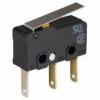 Touch and tactile sensor are devices which measures the parameters of a contact between the sensor and an object. This interaction obtained is confined to a small defined region. This contrasts with a force and torque sensor that measures the total forces being applied to an object. In robotics, tactile sensors provide useful information about the state of contact between a robot hand and an object in prehension. Cantact switches and bumpers are the exapmles of tactile sensors. Touch and tactile sensor are devices which measures the parameters of a contact between the sensor and an object. This interaction obtained is confined to a small defined region. This contrasts with a force and torque sensor that measures the total forces being applied to an object. In robotics, tactile sensors provide useful information about the state of contact between a robot hand and an object in prehension. Cantact switches and bumpers are the exapmles of tactile sensors.
 Infrared Sensors: Infrared Sensors:
An infrared sensor is an electronic device that emits and/or detects infrared radiation in order to sense some aspect of its surroundings. These sensors can be grouped as; intensity based infrared, modulated infrared and infrared ranging sensors.
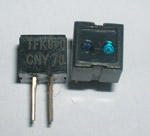  Intensity based infrared sensors are reflective sensors that are easy to implement and susceptible to ambient light. These sensors have an emitter and a detector part. They are used for object detection, line follower robots, wall tracking robots and optical encoders. Intensity based infrared sensors are reflective sensors that are easy to implement and susceptible to ambient light. These sensors have an emitter and a detector part. They are used for object detection, line follower robots, wall tracking robots and optical encoders.
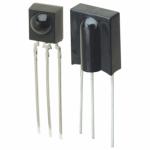  Modulated infrared sensors are proximity sensors that require modulated IR signal and that are insensitive to ambient light. These sensors flash a light source at a particular frequency. Modulated infrared sensors are used for obstacle avoidance and sumo robots. Modulated infrared sensors are proximity sensors that require modulated IR signal and that are insensitive to ambient light. These sensors flash a light source at a particular frequency. Modulated infrared sensors are used for obstacle avoidance and sumo robots.
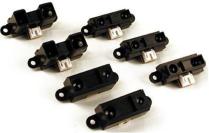  Infrared ranging sensors are distance sensors that are impervious to ambient light, color and reflectivity of object. They have IR emitter, focusing lens and position sensitive detector and they calculate the distance based on triangular geometry. Sharp IR ranger sensors are examples of these sensors. Infrared ranging sensors are distance sensors that are impervious to ambient light, color and reflectivity of object. They have IR emitter, focusing lens and position sensitive detector and they calculate the distance based on triangular geometry. Sharp IR ranger sensors are examples of these sensors.
 Ultrasonic Sensors: Ultrasonic Sensors:
 Ultrasonic sensors generate high frequency sound waves and evaluate the echo which is received back by the sensor. Sensors calculate the time interval between sending the signal and receiving the echo to determine the distance to an object. There are two transducers on an ultrasonic sensor. An ultrasonic transducer is a device that converts energy into ultrasound, or sound waves above the normal range of human hearing with a frequency between 20 kHz and 500 kHz. The ultrasonic sensors used in robot projects have usually 40 kHz frequency. Ultrasonic sensors generate high frequency sound waves and evaluate the echo which is received back by the sensor. Sensors calculate the time interval between sending the signal and receiving the echo to determine the distance to an object. There are two transducers on an ultrasonic sensor. An ultrasonic transducer is a device that converts energy into ultrasound, or sound waves above the normal range of human hearing with a frequency between 20 kHz and 500 kHz. The ultrasonic sensors used in robot projects have usually 40 kHz frequency.
 Encoders: Encoders:
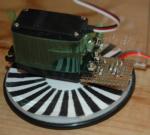 Digital optical encoders are devices that convert motion into a sequence of digital pulses. Rotary encoders are manufactured in two basic forms: the absolute encoder where a unique digital word corresponds to each rotational position of the shaft, and the incremental encoder, which produces digital pulses as the shaft rotates, allowing measurement of relative position of shaft. Encoders are used for determination of velocity, acceleration or position. Digital optical encoders are devices that convert motion into a sequence of digital pulses. Rotary encoders are manufactured in two basic forms: the absolute encoder where a unique digital word corresponds to each rotational position of the shaft, and the incremental encoder, which produces digital pulses as the shaft rotates, allowing measurement of relative position of shaft. Encoders are used for determination of velocity, acceleration or position.
 Inertial Sensors: Inertial Sensors:
 Inertial sensors are used in navigation. These sensors measure the second derivative of position. Accelerometers and gyroscopes are inertial sensors. An accelerometer measures the inertia force generated when a mass is affected by a change in velocity. A gyroscope measures the rate of rotation independent of the coordinate frame. Gyroscope consists of a spinning wheel which is able to take any orientation. Inertial sensors are used in navigation. These sensors measure the second derivative of position. Accelerometers and gyroscopes are inertial sensors. An accelerometer measures the inertia force generated when a mass is affected by a change in velocity. A gyroscope measures the rate of rotation independent of the coordinate frame. Gyroscope consists of a spinning wheel which is able to take any orientation.
 External Sensors: External Sensors:
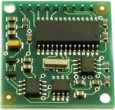 Digital compasses, laser range sensors, global positioning system (GPS), radar are the external sensors. Digital compasses are used for robot navigation based on the magnetic field of Earth. GPS is also used for navigation. A GPS receiver calculates its position by precisely timing the signals sent by the GPS satellites high above the Earth. Laser range finders are used for measurement of distance between robot and reflective surface. These are sensors with a range between 2 and 5000 meters. Radars are used to identify range, altitude, direction or speed. Digital compasses, laser range sensors, global positioning system (GPS), radar are the external sensors. Digital compasses are used for robot navigation based on the magnetic field of Earth. GPS is also used for navigation. A GPS receiver calculates its position by precisely timing the signals sent by the GPS satellites high above the Earth. Laser range finders are used for measurement of distance between robot and reflective surface. These are sensors with a range between 2 and 5000 meters. Radars are used to identify range, altitude, direction or speed.
|
|

